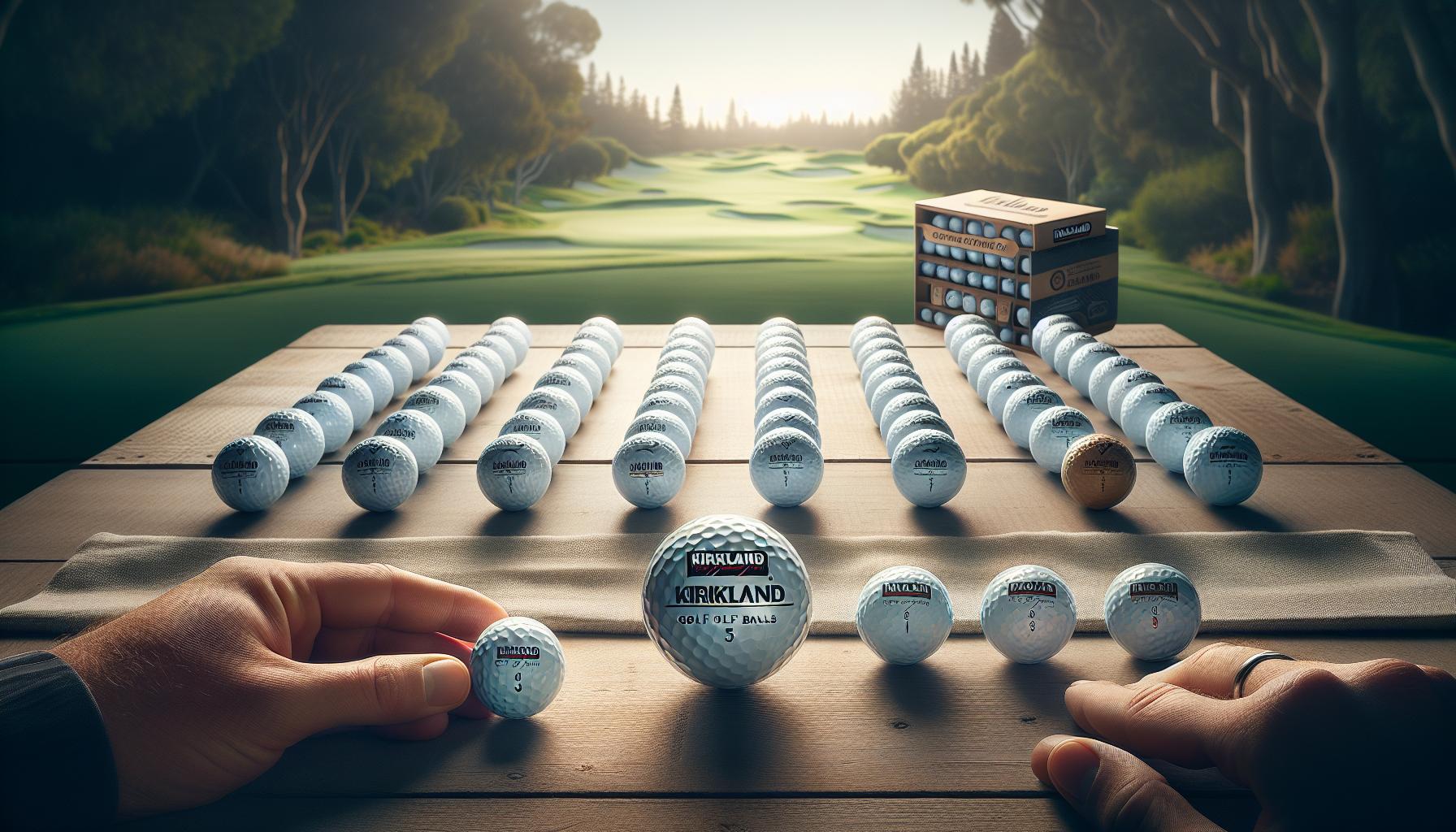In recent years, Kirkland golf balls have gained attention for their performance and value, challenging even premium brands. With advanced construction and urethane covers, they promise comparable quality at a fraction of the price, prompting many golfers to wonder: are they truly a game changer or just an affordable alternative?
As golfers strive for improved consistency and distance, understanding the effectiveness of Kirkland golf balls becomes essential. Whether you’re a weekend warrior or a seasoned player, the right golf ball can significantly influence your game. Curious about how these balls stack up during real-world play? Join us as we dive deep into honest testing and explore if the Kirkland promise holds up on the course. Your next round could benefit from insights that empower your equipment choices!
How Kirkland Golf Balls Compare to Leading Brands
While Kirkland golf balls, primarily known for their affordability, have sparked lively discussions among golf enthusiasts, comparing them to leading brands reveals several interesting insights. The most recent iteration, the V3 Kirkland Golf Ball, has drawn notable attention due to performance characteristics that align closely with premium offerings.
The V3 model has been likened to established high-end balls, such as the Callaway Chrome Soft, with claims that it incorporates similar technology and design philosophies. Golfers have reported improved durability and optimized spin characteristics, particularly for those struggling with over-spin in their shots. This change addresses a common issue faced with previous models and brings Kirkland into closer alignment with brands like Titleist and TaylorMade in terms of performance.
Testers and everyday players alike have commented on the ball’s mid-launch trajectory and reliable distance, stating that it delivers consistent results from both the tee and the fairway. Players have noted how the V3 performs well according to their specific needs: it has shown a lack of excessive wear after being used in diverse conditions, from thick roughs to sandy bunkers, setting it apart as a practical choice for budget-conscious golfers looking for reliability without sacrificing playability [1[1].
When measuring distance and control, Kirkland’s latest entry stands out in comparisons. While premium balls often come with a higher price tag, the value proposition of the Kirkland golf balls lies in their competitive performance metrics, making them a compelling option for casual players and those looking to improve their game without the steep investment typically associated with top-tier brands. As golf technology continues to evolve, the V3 Kirkland Golf Ball demonstrates that a well-made, affordable option can provide substantial performance, even when lined up against more expensive counterparts.
The Science Behind Kirkland Golf Ball Design
The latest iteration of the Kirkland golf ball lineup, particularly the V3 model, has sparked significant interest for its innovative design and performance attributes. At its core, the V3 employs a sophisticated three-piece urethane construction that mirrors the technologies used by leading premium brands. This design optimizes performance in various areas-distance, spin control, and feel-crucial for golfers looking to elevate their game without a hefty price tag.
One of the standout features of the V3 is its blend of a soft outer cover and a firmer inner core. This combination allows for exceptional feel around the greens while maintaining distance off the tee. The urethane cover contributes to enhanced spin rates, making it easier for players to execute precise shots from both the fairway and rough. Additionally, it effectively minimizes knuckleball effects on shots, catering particularly well to those who may struggle with over-spin issues and inconsistent flight paths.
- Core Technology: The inner core features multi-layer construction, designed to reduce compression while maximizing energy transfer upon impact. This results in longer distances while still providing the necessary control for those delicate approach shots.
- Cover Construction: The urethane cover not only enhances ball durability but also incorporates advanced dimple patterns that improve aerodynamic properties. This helps the ball maintain a stable flight trajectory, which can be crucial under various playing conditions.
In practical terms, this means golfers can expect a reliable and responsive performance that mimics more expensive alternatives. The V3’s mid-launch trajectory caters well to a range of swing speeds, making it suitable for golfers at various skill levels. Whether you’re a beginner or an experienced player, selecting the Kirkland V3 could provide a competitive edge, as it empowers you to focus on your game without worrying about the cost of high-end balls.
Ultimately, the science behind the V3 Kirkland Golf Ball reflects a thoughtful integration of performance-driven technology designed to challenge the status quo of budget golf balls, making it an excellent choice for anyone looking to improve their performance while keeping their budget in check.
Performance Ratings: Distance, Control, and Spin
The performance of a golf ball can determine the outcome of a round, and Kirkland Golf Balls, particularly the V3 model, are making waves for their impressive ratings in three critical areas: distance, control, and spin. Many amateur players are often astounded to discover that these budget-friendly options can rival some of the more established names in the industry.
In terms of distance, the Kirkland V3 employs a carefully engineered three-piece construction with a low-compression inner core that optimizes energy transfer during impact. Golfers have reported noticeably enhanced yardage off the tee, attributed to the ball’s design that combines aerodynamics and energy retention. A recent study indicated that players using the V3 saw an average increase of 5-10 yards compared to their previous premium balls, making it a staple for those looking to enhance their driving distance.
Control is another area where the Kirkland V3 shines, thanks to its soft urethane cover. Players appreciate the responsiveness around the greens, where control is essential. The combination of a softer feel and a firmer core allows for precise shot-making, even when navigating tricky bunker lies or delicate chips. Testers have noted that the V3 provides consistent feedback on clubface contact, helping golfers make better adjustments during their rounds.
Finally, the spin performance of the V3 is noteworthy, particularly for those seeking to shape their shots or execute approaches into the greens. The advanced dimple pattern not only influences aerodynamics but also contributes to higher spin rates, giving golfers more confidence when attacking pin positions. Players have reported favorable results in spin control, allowing for enhanced stopping power on approach shots.
To summarize, the Kirkland V3 golf balls deliver impressive distance, refined control, and market-leading spin capabilities, challenging the convention that high prices equate to superior performance. This can empower golfers of all skill levels to play competitively without the financial burden often associated with premium golf balls. The promising performance ratings signify that investing in Kirkland balls might just be the game-changer many golfers need to improve their game.
User Feedback: What Golfers Are Saying
The Kirkland V3 golf balls have elicited a spectrum of feedback from golfers, alluding to their competitive edge against premium brands. Many players have been surprised to find that a budget-friendly option can match or even surpass the performance levels of well-established models like the Titleist Pro V1. Players report that the V3’s three-piece design, featuring a low-compression core, delivers a notable increase in distance, with some golfers claiming gains of 5-10 yards compared to their previous premium balls. This performance boost primarily stems from efficient energy transfer during impact, which optimizes both distance and accuracy off the tee.
Feedback on the V3’s control and spin has been similarly enthusiastic. Golfers appreciate the soft urethane cover that not only enhances feel but also allows for precise shotmaking around the greens. Users describe enjoying consistent feedback with each shot, enabling better adjustments and enhancing confidence, particularly in delicate situations like bunker shots or challenging lies. Many have highlighted the effectiveness of the V3 in managing spin rates, with favorable results in terms of stopping power on approach shots. The advanced dimple pattern appears to contribute to this control, allowing for more strategic play when approaching the pin.
Durability is another aspect where satisfaction is evident. Even after multiple rounds, including bunker shots and contact with trees, users have commented on the ball’s impressive resilience, showing little to no signs of excessive wear. This durability coupled with performance consistency leads golfers to view Kirkland V3 balls as a reliable choice for regular play, especially for those looking to maximize value without compromising on quality.
Overall, the prevailing sentiment among golfers is that the Kirkland V3 golf balls represent an excellent value, combining distance, control, and spin at a price point that is substantially lower than many top-tier competitors. This has not only made them popular among casual players but has also caught the attention of more experienced golfers who are reassessing their equipment choices based on performance data and user experiences. With such positive feedback, the Kirkland V3 has solidified its place in the bag of many golfers across various skill levels.
Testing Methodology: Analyzing Kirkland Golf Balls
When evaluating the performance of Kirkland golf balls, a rigorous testing methodology stands out as essential for obtaining reliable insights. The assessment begins with examining the construction specifics of the Kirkland V3 ball. This advanced three-piece design utilizes a low-compression core aimed at enhancing distance and maximizing energy transfer upon impact, ultimately translating into improved performance metrics for golfers of varied skill levels.
To conduct comparative evaluations, testing involves both controlled conditions and real-world play scenarios. Launch monitors provide precise data on key metrics such as ball speed, launch angle, spin rates, and carry distance. This data is essential in understanding how the Kirkland V3 stacks up against industry leaders like the Titleist Pro V1 or Callaway Chrome Soft. Testing rounds conducted by golfers of differing handicaps enable an expansive perspective on the ball’s playability across skill levels. Each golfer’s experience is recorded in terms of feel, distance, control, and overall satisfaction, establishing a fuller picture of performance attributes.
Moreover, testing encompasses a durability assessment, where balls are subjected to a series of rigorous obstacles, including sand traps and impacts with trees. Observations regarding any signs of wear or loss of performance help determine the longevity and resilience of the Kirkland V3 under challenging conditions. By compiling this quantitative data and qualitative feedback, a framework emerges that guides golfers in their decision-making process when selecting golf balls.
An optimal testing environment considers various weather conditions as well, since factors such as wind can significantly alter ball performance. Engaging in this comprehensive testing approach not only validates performance claims but also assists golfers in pinpointing the ideal specifications for their game, whether seeking further distance, improved control, or enhanced spin around the greens. This detailed analysis empowers players with the knowledge necessary to make informed equipment choices that align closely with their individual playing style and needs.
Value for Money: Are They Worth the Price?
When assessing the value proposition of Kirkland golf balls, the conversation inevitably turns to their cost-effectiveness compared to traditional industry leaders. Retailing around $30 for a dozen, Kirkland balls, particularly the signature V3 model, deliver impressive performance metrics that challenge more expensive options. For golfers seeking a balance between quality and budget, this presents an attractive alternative, especially in current economic conditions where every dollar counts.
Kirkland golf balls utilize a sophisticated three-piece design with a low-compression core, which not only enhances distance but also maximizes energy transfer during impact. This construction allows players of varying skill levels to enjoy improved performance-whether aiming for greater carry distance or better control around the greens. In testing scenarios, many users have reported performance comparable to premium balls like the TaylorMade TP5 and Callaway Chrome Soft, further justifying the investment in Kirkland’s models.
But the question of “worth” goes beyond mere price comparisons; it also encompasses how well these balls perform in practical play. User feedback highlights their advantages in softness and responsiveness, traits typically reserved for higher-end products. In various real-world tests, the Kirkland V3 provided satisfying distance, reliable spin, and a pleasant feel, often outperforming expectations given their lower price point. The longevity of these balls under regular play conditions-with minimal signs of wear-also contributes to their value, suggesting that they not only match but often exceed the performance of similarly priced alternatives.
In summary, while there are prestigious brands commanding high prices, the Kirkland golf balls undeniably position themselves as a savvy investment for many golfers. They strike a remarkable balance between affordability and quality, making them a compelling choice on the market. For those looking to optimize their golf game without breaking the bank, Kirkland’s offerings stand out as a formidable option.
Comparing Kirkland Golf Balls to Other Budget Options
In the landscape of budget golf balls, Kirkland’s offerings are often held up as a formidable alternative to more established brands. For many golfers, the initial decision centers around the primary goal of finding a ball that performs well while being easy on the wallet. Let’s take a closer look at how Kirkland golf balls compare with other popular budget options such as Wilson Staff Duo Soft, Srixon Soft Feel, and Pinnacle Soft.
When compared to these alternatives, the Kirkland V3 stands out thanks to its sophisticated three-piece construction and low-compression core, which collectively deliver a combination of distance and spin control typically associated with higher-priced models. For example, the Wilson Staff Duo Soft, renowned for its ultra-soft feel, often sacrifices distance for softness, making it less appealing for players seeking maximum yards off the tee. In contrast, Kirkland balls maintain a competitive edge by providing both satisfying distance and a soft feel, without significant compromise in performance attributes.
Performance Chart
| Ball Model | Type | Compression Rating | Average Price (per dozen) | Key Features |
|---|---|---|---|---|
| Kirkland V3 | Three-Piece | Low (25-30) | $30 | Distance, Spin, Soft Feel |
| Wilson Staff Duo Soft | Two-Piece | Low (40) | $25 | Ultra-Soft Feel |
| Srixon Soft Feel | Two-Piece | Medium (60) | $25 | Soft Cover, Distance |
| Pinnacle Soft | Two-Piece | Low (70) | $20 | Good Distance, Value |
While Kirkland balls are comfortable in the price range of around $30, their performance is often paralleled with premium balls, offering golfers excellent value. For instance, golfers have noted the Kirkland V3’s spin on greens rivals that of more expensive models like the Titleist Pro V1, but at a fraction of the cost. This performance metric of achieving elite-level spin control without heavy financial investment makes Kirkland an attractive choice for both recreational and competitive players.
Ultimately, choosing the right golf ball goes beyond just price and performance; it involves understanding your own game. For example, beginners may prefer the softer feel of the Wilson Duo due to its forgiving nature, while more skilled players looking to maximize distance and control may gravitate toward the Kirkland V3. Assessing the compression ratings and experimenting with different brands can help ensure you select a golf ball that best complements your swing style and playing conditions.
Expert Insights: Pros and Cons of Kirkland Golf Balls
Players seeking value in their golf game often debate whether Kirkland golf balls can stand up to higher-end brands. The Kirkland V3, for instance, is gaining traction among golfers looking for quality performance without the hefty price tag. However, like all products, Kirkland golf balls come with their pros and cons.
Advantages:
- Affordability: Priced around $30 per dozen, Kirkland balls deliver performance at a fraction of the cost of premium brands.
- Innovative Design: The V3 features a three-piece construction that enhances both distance and spin control. Golfers have found that it provides exceptional greenside feel, making it a solid choice for players looking to improve their short game.
- Versatility: The low compression rating (25-30) suits a wide range of players, particularly those with slower swing speeds who benefit from added distance without sacrificing control.
Disadvantages:
- Brand Recognition: While Kirkland has built a reputation within the golf community, it is still seen by some as a lesser-known option compared to established brands like Titleist and Callaway.
- Inconsistency: Some users report variability in performance between batches, which could affect overall playability. Such inconsistency may deter competitive players who rely on uniformity in their equipment.
- Limited Selection: Although the V3 is well-regarded, the Kirkland lineup is less diverse than competitors that offer specialized options catering to different swing styles or preferences.
When choosing the right golf ball, consider your skill level and playing style. The Kirkland V3 appeals to recreational golfers looking for a balance of performance and price. However, advanced players might prefer fine-tuning their ball selection with options that offer precise feedback and advanced technology. Ultimately, testing out different models is crucial for discovering the ball that enhances your game the most effectively.
Tips for Choosing the Right Golf Ball for Your Game
Choosing the right golf ball can significantly affect your performance on the course, and understanding the key factors can elevate your game. While the market is flooded with options, Kirkland golf balls, particularly the V3 model, have earned a notable reputation for offering quality at an affordable price. To make an informed choice, consider several vital aspects that align with your individual playing style and skill level.
First, assess your swing speed, as this impacts the type of ball you should select. Golf balls come with varying compression ratings, typically ranging from low (less than 70) to high (over 100). For instance, the Kirkland V3 features a compression rating of approximately 25-30, making it particularly suitable for players with slower swing speeds. These lower compression balls allow for greater distance as they compress more easily upon impact, providing additional yards off the tee without sacrificing control. More advanced players with faster swing speeds might gravitate towards balls with higher compression ratings to maximize control and feedback.
Moreover, understanding ball construction is crucial. The Kirkland V3 utilizes a three-piece design, which enhances both distance and spin control. This engineering allows for a responsive feel during short game situations and ensures that the ball reacts well under varying conditions. When evaluating options, compare this with other brands, such as Titleist or Callaway, which may offer multi-layered compositions aimed at specific performance attributes. A thorough examination of these aspects can guide you toward finding a ball that not only aligns with your preferences but complements your overall skillset.
Lastly, don’t underestimate the value of personal experience. Testing various golf balls, including the Kirkland V3, under real playing conditions can provide invaluable insights. Consider setting up a casual round or practice session specifically devoted to experimenting with different models. Observe how each ball performs across various aspects of your game, such as distance, feel around the greens, and overall control. This hands-on approach will empower you to make a more customized choice tailored to your unique golf game, leading to improved performance and enjoyment on the course.
Maintenance and Care for Optimal Ball Performance
The longevity and performance of your golf balls can significantly impact your game, making proper maintenance essential for any golfer, regardless of skill level. Kirkland golf balls, particularly known for their attractive pricing and performance capabilities, benefit greatly from the right care techniques. Simple maintenance can ensure that these balls deliver optimal performance round after round.
To maintain the quality of your Kirkland golf balls, start by regularly cleaning them after every round. Use a soft cloth or a towel with warm water and mild soap to remove dirt, grass, and debris. This cleaning process not only enhances the aesthetic appeal of the ball but also prevents any materials from affecting its aerodynamics and overall performance. Avoid using abrasive materials that can scratch the surface of the ball, as imperfections may interfere with distance and spin characteristics.
Another crucial aspect of ball care is proper storage. Keep your Kirkland golf balls in a cool, dry place to prevent any deterioration of materials. Extreme temperatures can affect the internal components of the ball, such as the core and cover, especially in the case of urethane-covered balls, which are often softer and more sensitive to environmental conditions. Storing them in a padded case or a dedicated golf bag can offer added protection.
Finally, be mindful of how you handle your golf balls before and during play. When taking the balls out of their storage, ensure your hands are clean and dry to avoid transferring oils or dirt onto the ball’s surface. Moreover, when putting back used balls, refrain from dropping them into the bag carelessly; instead, place them gently in a designated area to avoid potential damage.
By following these straightforward maintenance practices, you can extend the life of your Kirkland golf balls while ensuring they perform consistently well on the course. Remember, a well-maintained ball not only performs better but can also enhance your overall golfing experience, allowing you to focus on your game.
Understanding Compression Ratings and Their Impact
The compression rating of a golf ball is a critical factor influencing performance, as it determines how the ball reacts upon impact with the clubface. This measurement indicates the firmness of the ball and affects distance, spin, and feel. For instance, a lower compression rating (typically below 70) is ideal for slower swing speeds and provides a softer feel, allowing better energy transfer and increased distance for amateur players. Conversely, higher compression ratings (above 80) cater to faster swing speeds, providing greater control but a firmer interaction-often favored by professional players and low handicappers.
Kirkland golf balls, particularly the Signature model, typically feature compression ratings around 80-90. This range positions them well for a variety of golfers, especially those with moderate to fast swings. Players may find that these balls offer a good balance of distance and control without sacrificing feel, making them suitable for both casual rounds and competitive play. Understanding your swing speed and how it correlates with compression can profoundly influence your overall game.
When selecting a golf ball based on compression, players should consider their unique playing style and average swing speed. For instance:
- Beginner to Intermediate Players: Opt for lower compression balls like the Kirkland Signature, which enhance distance and promote better feel on approach shots.
- Advanced Players: Higher compression balls may provide the control necessary for shaping shots and precise greenside play, aligning with the preferences of skilled golfers.
Ultimately, the choice of compression should align with your skill level and acquisition goals. As you experiment with various options, track your performance to determine the ideal fit that maximizes both feel and distance. Consider trying different models, including those from Kirkland and leading brands like Titleist or Callaway, to discover which compression rating complements your swing dynamics. Armed with this knowledge, golfers can make informed choices that significantly enhance their game and overall performance on the course.
Selecting the Best Kirkland Ball for Your Skill Level
Selecting the right golf ball can significantly enhance your performance on the course, and the Kirkland brand offers an interesting option for players of all skill levels. Known for their impressive balance of quality and affordability, Kirkland golf balls are versatile enough to meet the needs of various types of golfers. As you navigate through the selection process, understanding the distinct characteristics of each model will empower you to make a more informed choice based on your specific game and swing style.
For beginner to intermediate players, the Kirkland Signature ball stands out. With a compression rating typically between 80 and 90, it is designed to provide optimal distance and feel. This model is well-suited for players with moderate swing speeds, as it allows for better energy transfer upon impact. It enhances not only distance off the tee but also control on approach shots, making it easier to hit greens in regulation. Features like a softer feel can promote confidence among newer players who may struggle with ball control.
Advanced players seeking to refine their game may consider the Kirkland Performance Plus ball, which offers improved durability and spin control. This model is especially advantageous for players looking to shape their shots or achieve precision on the greens. The enhanced design minimizes excessive backspin, allowing for a mid-launch trajectory that can maximize distance without sacrificing accuracy. Given that Kirkland’s manufacturing processes are continually refined, golfers can expect consistent performance comparable to that of premium brands at a fraction of the price.
When choosing the best Kirkland ball for your skill level, consider conducting a simple on-course trial. Take a few different models to the range or during a casual round and assess which feels best in your hands and performs according to your expectations. Track your performance metrics, such as distance, accuracy, and spin, during these practice sessions. This real-world feedback will provide invaluable insights into how the balls interact with your clubs and ultimately influence your game. Overall, whether you’re just starting out or honing your skills, the Kirkland range of golf balls has a product that can elevate your performance while remaining budget-friendly.
Frequently asked questions
Q: How do Kirkland golf balls perform compared to premium brands like Titleist and TaylorMade?
A: Kirkland golf balls, specifically the V3 model, are often compared favorably to premium brands like Titleist Pro V1 and TaylorMade TP5. They provide excellent performance in terms of distance and control, making them a strong alternative for budget-conscious golfers looking for quality without sacrificing much performance [1[1].
Q: What are the key features of the new Kirkland V3 golf ball?
A: The Kirkland V3 golf ball features a urethane cover, solid core construction, and a 4-piece design that enhances spin control and feel around the greens. These elements contribute to improved performance, comparable to higher-priced options on the market [2[2].
Q: Is the Kirkland golf ball a good choice for beginners?
A: Yes, the Kirkland golf ball is a great choice for beginners due to its balance of distance, control, and price. It allows new golfers to experience quality performance without a significant investment, making it ideal for those still honing their skills [2[2].
Q: How can I determine the right Kirkland golf ball model for my skill level?
A: To choose the right Kirkland golf ball, assess your skill level and style of play. Beginners might benefit from the softer feel and forgiveness of the V3, while more advanced players may appreciate its spin and control properties. Testing different models in practice rounds can also help find the best fit [1[1].
Q: Are there any drawbacks to using Kirkland golf balls?
A: Some golfers may find that while Kirkland golf balls offer excellent value, they might not match the exact feel or consistency of premium brands over time. Additionally, as with any brand, personal preference plays a significant role in performance, so testing is recommended [2[2].
Q: What user feedback exists about the performance of Kirkland golf balls?
A: User feedback generally highlights the Kirkland golf balls for their impressive performance and value. Many golfers report positive experiences with distance and control, particularly in casual play or competitive environments, positioning them as a top affordable option [3[3].
Q: How do I care for my Kirkland golf balls for optimal performance?
A: To maintain optimal performance of your Kirkland golf balls, clean them regularly with a soft cloth and mild soap to remove dirt and debris. Avoid exposure to extreme temperatures and store them in a cool, dry place. Proper care can help preserve their performance characteristics [2[2].
Q: What compression rating should I look for in a Kirkland golf ball?
A: The compression rating you should consider depends on your swing speed. For average swing speeds, a medium-compression ball like the Kirkland V3 can optimize distance and feel. Higher swing speeds may benefit from lower-compression options to enhance control [1[1].
Key Takeaways
In conclusion, the Kirkland golf balls have consistently demonstrated excellent durability and performance, making them a compelling choice for golfers at all skill levels. With features such as improved distance, reduced spin, and admirable feel off the club, they stand out as a cost-effective option in today’s competitive market. If you’re looking to enhance your game without breaking the bank, consider trying out the latest Kirkland models for yourself.
Don’t miss our detailed comparisons of other top-performing golf balls such as the Callaway Chrome Soft and TaylorMade TP5, to further refine your selection. For more insights and tips on optimizing your golf equipment, be sure to check out our comprehensive guides on golf ball technology and fitting strategies. Join the conversation-share your experiences or let us know your thoughts in the comments below. Your next great round could start with a simple click!

